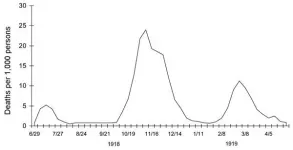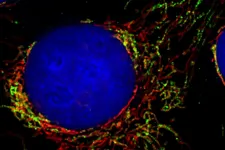(Press-News.org) New research has found marine seismic surveys used in oil and gas exploration are not impacting the abundance or behaviour of commercially valuable fishes in the tropical shelf environment in north-western Australia.
The research is the first of its kind to use dedicated seismic vessels to measure the impacts of the survey's noise in an ocean environment, with the eight-month experiment conducted within a 2500 square kilometre fishery management zone near the Pilbara coast.
It involved using multiple acoustic sensors, tagging 387 red emperor fish and deploying more than 600 underwater cameras to track and measure fish behaviour before and after firing seismic air guns into the ocean.
Australian Institute of Marine Science (AIMS) Principal Researcher and project leader Dr Mark Meekan said the large-scale experiment measured the short-term and long-term effects of seismic airguns on the community of commercially important species in the region, such as red emperor (Lutjanus sebae).
"What makes this research unique and robust is we used an actual seismic vessel in a real ocean environment and some of the most advanced technologies to track and measure possible impacts," he said.
"Commercial fishers are concerned seismic survey noise could change the abundance and behaviour of key fish species - this research directly sought to determine if commercially valuable fish leave the area or hide when exposed to the seismic noise.
"The results reveal there were no short-term or long-term effects on the abundance, behaviour and movement of bottom-living fishes.
"This suggests seismic surveys have little impact on commercially valuable fish species in this environment."
AIMS acoustic scientist and co-author Dr Miles Parsons said Baited Remote Underwater Video Systems (BRUVS) were deployed to document the movements, feeding patterns and abundance of the entire benthic fish community.
Red emperor fish - an important target of fisheries - were tagged and tracked via an array of acoustic telemetry receivers to understand their movements.
"It was surprising to find no changes in the key behaviours we were assessing after the fish were exposed to seismic blasts," he said.
This research fills in a key knowledge gap in the effect of seismic exploration on fisheries in the area, which is necessary for managers, marine industries, and policy makers to make informed decisions about its sustainable use.
"The magnitude and extent of this study also means the results provide valuable knowledge on potential impacts in other environments, not just in Australia, but internationally."
The research experiment is part of the North West Shoals to Shore Research Program. The program also investigates impacts on pearl oysters, with this study still in progress.
INFORMATION:
The research was a collaboration between AIMS, University of Western Australia, Curtin University, University of Tasmania and the Department of Primary Industries and Regional Development.
The research paper 'Large-scale experiment finds no evidence that a seismic survey impacts a demersal fish fauna' is published in Proceedings of the National Academy of Sciences.
AIMS' North West Shoals to Shore Research Program is supported by Santos as part of the company's commitment to better understanding Western Australia's marine environment.
Images and vision:
Download: https://cloudstor.aarnet.edu.au/plus/s/FaqqI5Jh1Bf0jG7
Media contact:
Principal Researcher and project leader, Dr Mark Meekan: 0429 101 812
Media Officer, Molly Knapton: media@aims.gov.au; 0448 887 697
KRAS was one of the first oncogenes to be identified, a few decades ago. It is among the most common drivers of cancer and its mutations can be detected in around 25 per cent of human tumours. The development of KRAS inhibitors is, thus, an extremely active line of research. Effective results have been elusive so far, though - no KRAS inhibitor had been available until a month ago, when the FDA granted approval to Sotorasib.
KRAS encodes two gene products, KRAS4A and KRAS4B, whose levels can vary across organs and embryonic stages. When KRAS mutates, both variants, or isoforms, are activated. Though, some studies have focussed on approaches to target only KRAS4B, since it usually found to be expressed at ...
Evidence shows that early detection and treatment of cancer can significantly improve health outcomes, however women in Mississippi, particularly in underserved populations, experience the worst health outcomes for cervical, breast, and oropharyngeal cancer. ...
From the onset of the COVID-19 pandemic there have been countless comparisons to the 1918 influenza pandemic in terms of overall medical impact. Many of the comparisons addressed overall cases which, given the lack of a confirmatory lab test in 1918 and no meaningful case definitions for both pandemics, make such comparisons patently invalid. Overall mortality comparisons, although methodologically flawed as well, do offer a reasonably comparative outcome measure and offers a greater degree of validity. This measure is further enhanced when adjusted for population and average life years lost (see accompanying table for mortality comparisons ...
Researchers at Michigan Medicine have discovered yet another functional autoantibody in COVID-19 patients that contributes to the disease's development and the "firestorm" of blood clots and inflammation it induces.
A growing body of studies suggests COVID-19 emulates many aspects of systemic autoimmune disorders, including the release of a flurry of overactive immune cells that produce toxic webs of proteins and DNA called neutrophil extracellular traps, or NETs.
For this study, the team analyzed serum from over 300 hospitalized COVID patients, searching for a novel autoantibody that shields the toxic NETs from being destroyed and produces a lasting ...
The link between on-road traffic and air pollution is well-known, as are the negative health impacts of pollution exposure. However, the many factors that may influence commuters' exposure to pollutants - such as frequency, time, and duration of commute - and the overall impact of commuting remains a matter of on-going scientific discovery.
Dr. Jenna Krall, assistant professor at the George Mason University College of Health and Human Services, is using statistical methods to better understand exposure to air pollution. Krall studies how commuting patterns impact exposure to fine particulate matter ...
EAST LANSING, Mich. - Tens of millions of patients around the world suffer from persistent and potentially life-threatening wounds. These chronic wounds, which are also a leading cause of amputation, have treatments, but the cost of existing wound dressings can prevent them from reaching people in need.
Now, a Michigan State University researcher is leading an international team of scientists to develop a low-cost, practical biopolymer dressing that helps heal these wounds.
"The existing efficient technologies are far too expensive for most health care systems, ...
Researchers at the University of Maryland School of Medicine (UMSOM) launched a new online tool that could more quickly advance medical discoveries to reverse progressive hearing loss. The tool enables easy access to genetic and other molecular data from hundreds of technical research studies involving hearing function and the ear. The research portal called gene Expression Analysis Resource (gEAR) was unveiled in a study last month in Nature Methods. It is operated by a group of physician-scientists at the UMSOM Institute for Genome Sciences (IGS) in collaboration with their colleagues at other institutions.
The portal allows researchers to rapidly access data and provides easily interpreted visualizations of datasets. Scientists can also input ...
New Curtin University-led research has called into question existing health advice that mothers wait a minimum of two years after giving birth to become pregnant again, in order to reduce the risk of adverse pregnancy outcomes, such as preterm and small-for-gestational age births.
The research found that a World Health Organization (WHO) recommendation to wait at least 24 months to conceive after a previous birth may be unnecessarily long for mothers in high-income countries such as Australia, Finland, Norway and the United States.
Lead researcher ...
Errors in the metabolic processes of mitochondria are responsible for a variety of diseases such as Parkinson's and Alzheimer's. Scientists needed to find out just how the necessary building blocks are imported into the complex biochemical apparatus of these cell areas. The TOM complex (translocase of the outer mitochondrial membrane) is considered the gateway to the mitochondrion, the proverbial powerhouse of the cell. The working group headed by Professor Chris Meisinger at the Institute of Biochemistry and Molecular Biology at the University of Freiburg has now demonstrated - in human cells - how signaling molecules control this gate. A signaling protein called DYRK1A modifies the molecular machinery of TOM and makes it more permeable ...
Three decades ago, child development researchers found that low-income children heard tens of millions fewer words in their homes than their more affluent peers by the time they reached kindergarten. This "word gap" was and continues to be linked to a socioeconomic disparity in academic achievement.
While parenting deficiencies have long been blamed for the word gap, new research from the University of California, Berkeley, implicates the economic context in which parenting takes place -- in other words, the wealth gap.
The findings, published this month in the journal Developmental Science, provide the first evidence that parents may talk less to their kids when experiencing financial scarcity.
"We were interested in what happens when parents think about or experience financial scarcity ...



